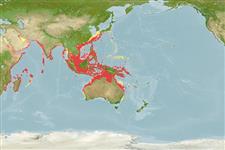Common names from other countries
分类 / Names
俗名 | 同种异名 | Catalog of Fishes(属, 种) | ITIS | CoL | WoRMS | Cloffa
Teleostei >
Eupercaria/misc (Various families in series Eupercaria) >
Lutjanidae (Snappers) > Lutjaninae
Etymology: Lutjanus: Malay, ikan lutjan, name of a fish.
More on author: Cuvier.
Environment: milieu / climate zone / depth range / distribution range
生态学
海洋; 半咸淡水 礁区鱼类; 深度上下限 5 - 180 m (Ref. 6390). 熱帶; 34°N - 35°S, 30°E - 171°E (Ref. 55)
Indo-West Pacific: southern Red Sea and East Africa to New Caledonia, north to southern Japan, south to Australia.
印度-西太平洋: 紅海南部而且東非到新加勒多尼亞, 北至日本南部, 南至澳洲。
Length at first maturity / 大小 / 重量 / 年龄
Maturity: Lm 54.2, range 49 - ? cm
Max length : 116 cm FL 雄鱼/尚未辨别雌雄; (Ref. 5738); common length : 60.0 cm TL 雄鱼/尚未辨别雌雄; (Ref. 55); 最大体重: 32.7 kg (Ref. 5738); 最大年龄: 40 年 (Ref. 96972)
背棘 (总数) : 11; 背的软条 (总数) : 15 - 16; 臀棘: 3; 臀鳍软条: 10. Dorsal profile of head steeply sloped. Preorbital bone broad. Preopercular notch and knob moderately developed. Scale rows on back rising obliquely above lateral line. Generally red or pink, darker on the back; fins are red except the pectorals which is pink. Juveniles and small adults have a dark red band from first dorsal spine through eye to tip of snout; a 2nd band from mid-dorsal fin to pelvic fin; a 3rd from base of last dorsal spine to caudal peduncle. Large adults become uniformly red (Ref. 9710). Note: (TL, cm) = 1.00 + 1.24 (SL, cm); n = 828 (Ref. 1450). Body depth 2.6-3.0 in SL (Ref. 90102).
头部的背面轮廓非常陡峭。 眶前骨宽的。 前鳃盖骨凹槽与疖瘤适度发展的。 鳞片列背面斜向上升在侧联机面。 通常红色或粉红的, 比较黑的在背部上; 鳍是红色的除胸鳍是粉红色。 稚鱼与小的成鱼有一个来自第一背鳍棘的暗红色条纹经过眼睛到吻尖; 一条从背部中央鳍到腹鳍的第二条条纹; 一第三从最后背棘到尾柄的基底。 大的成鱼变成均匀红色。 (参考文献 9710) 附注: (TL, 公分)=1.00+1.24;(SL, 公分) n=828.(参考文献 1450)
Adults occur in the vicinity of coral or rocky reefs (Ref. 5484), often over adjacent sand flats and gravel patches (Ref. 55). Also trawled in deeper water on relatively flat bottoms. Juveniles are frequently commensal with sea urchins (Ref. 55). Juveniles less than 20 cm long are common in near shore, turbid waters (Ref. 27260), in mangrove areas (Ref. 55), or among both coastal and deeper water offshore reefs (Ref. 27260). Juveniles can also be found swimming amongst the spines of urchins in shallow coastal bays (Ref. 48635). They move to deeper waters as they grow larger (Ref. 27264), with large fish often moving into shallower water during the winter months (Ref. 27260, 27264). They form schools of similar-sized individuals or are solitary (Ref. 6390). Feed on fishes, crabs, stomatopods, other benthic crustaceans and cephalopods. Marketed fresh, dried-salted and frozen (Ref. 9987). Commercially important but in certain regions of the Indian Ocean, large individuals are known to cause ciguatera poisoning (Ref. 11888).
出现在珊瑚礁或岩礁 (参考文献 5484) 的邻近区域, 时常在毗连的沙地浅滩与砾石区块上面.(参考文献 55) 也在相当平坦底部上拖网捕获在深水中。 稚鱼是时常与海胆共生.(参考文献 55) 稚鱼少于 20 公分长是常见于近岸,浑浊的水域 (参考文献 27260), 在红树林区域 (参考文献 55) 中, 或在海岸与水较深的外海礁石之中.(参考文献 27260) 稚鱼也能被发现游动在水浅的近岸海湾中在海胆的棘中。 (参考文献 48635) 当他们生长比较大的 (参考文献 27264) 的时候,他们移动到比较深的水域, 大鱼时常在冬天期间迁进较浅的水域数个月.(参考文献 27260,27264) 他们大小相近个体形成鱼群或者是独居性的。 (参考文献 6390) 捕食鱼,螃蟹,口足目甲壳类,其他的底栖甲壳动物与头足类动物。 在市场上销售生鲜地了, 乾燥盐腌与冷冻.(参考文献 9987) 商业重要但是在印度洋的特定区域中,大的个体被知道引起热带海鱼中毒.(参考文献 11888)
Emperor red snappers are broadcast spawners (Ref. 28009).印度-西太平洋: 紅海南部而且東非到新加勒多尼亞, 北至日本南部, 南至澳洲。
Allen, G.R., 1985. FAO Species Catalogue. Vol. 6. Snappers of the world. An annotated and illustrated catalogue of lutjanid species known to date. FAO Fish. Synop. 125(6):208 p. Rome: FAO. (Ref. 55)
CITES (Ref. 128078)
Not Evaluated
人类利用
渔业: 商业性; 养殖: 商业性; 游钓鱼种: 是的; 水族馆: 商业性
工具
特别资料
下载 XML
网络资源
Estimates based on models
Preferred temperature (Ref.
115969): 22.9 - 28.5, mean 27.1 (based on 1153 cells).
Phylogenetic diversity index (Ref.
82804): PD
50 = 0.5000 [Uniqueness, from 0.5 = low to 2.0 = high].
Bayesian length-weight: a=0.01413 (0.01053 - 0.01895), b=3.03 (2.94 - 3.12), in cm Total Length, based on LWR estimates for this species (Ref.
93245).
营养阶层 (Ref.
69278): 4.1 ±0.4 se; based on diet studies.
回复力 (Ref.
120179): 中等的, 族群倍增时间最少 1.4 - 4.4年 (K=0.13-0.38; tmax=35; Fec=5 million).
Fishing Vulnerability (Ref.
59153): High vulnerability (59 of 100).
